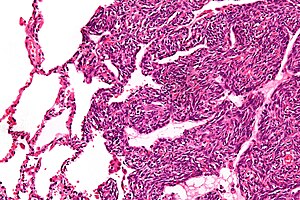Synovial sarcoma
| Synovial sarcoma | |
|---|---|
| Other names | Malignant synovioma |
 | |
| Micrograph of a monophasic synovial sarcoma. The histologic appearance is non-specific and overlaps with MPNST and fibrosarcoma. H&E stain. | |
| Specialty | Oncology |
A synovial sarcoma (also known as: malignant synovioma[1]) is a rare form of cancer which occurs mainly in the arms or legs, and affects tissue around the joints. It is a slow growing cancer[2] and a type of soft-tissue sarcoma.
The name "synovial sarcoma" was created early in the 20th century, as some researchers thought that the microscopic similarity of some tumors to synovium.[3]
It affects about 1,000 people each year. It is most often seen in people under age 30 and more common in males. The survival rate is 75% at 1 years to 45% at 5 years, but this does not mean a patient with synovial sarcoma will only live from 1 to 5 years[4]. Unfortunately, synovial sarcoma can come back many years later.
References[change | change source]
- ↑ "Synovioma". Encyclopædia Britannica Online. Retrieved 20 May 2012.
- ↑ "Synovial Sarcoma: What Is It, Diagnosis, Treatment & Prognosis". Cleveland Clinic. Retrieved 2024-05-22.
- ↑ Raphael E. Pollock, ed. (2002). Soft Tissue Sarcomas. American Cancer Society Atlas of Clinical Oncology. BC Decker. ISBN 155009128X.
- ↑ "Survival for soft tissue sarcomas". www.cancerresearchuk.org. Retrieved 2024-05-22.
